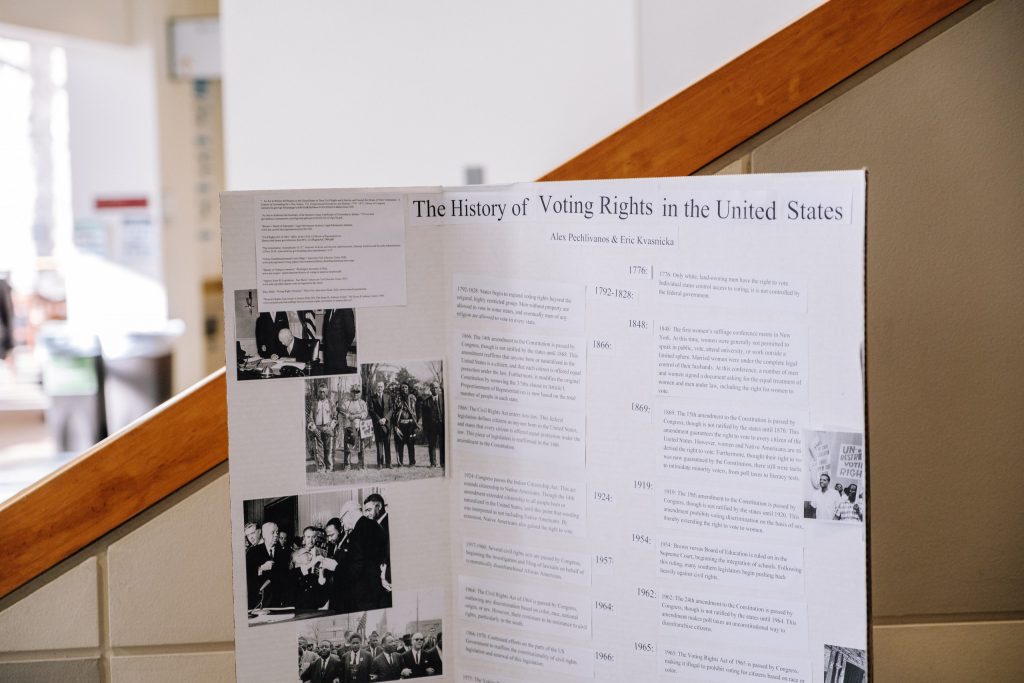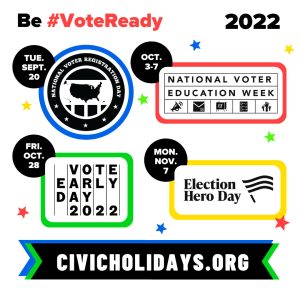
Include Important Election Dates
| September 20, 2022 | National Voter Registration Day |
| September 23, 2022 | Absentee voting begins in MN Voters in Rice County can visit Northfield City Hall to absentee vote! |
| October 18, 2022 | Last day for voter pre-registration |
| November 5, 2022 | Special Saturday early voting hours at Northfield City Hall (10 am-3 pm) |
| November 7, 2022 | Last day to request a mail in ballot or vote absentee in MN |
| November 8, 2022 | MIDTERM ELECTION DAY Same day registration in MN |
Syllabus Statement About Election Engagement
Combine, adapt, and edit the statements below or make your own!
2022 Election Engagement
I believe that healthy democracies and communities rely on active participation of its members.
If you’re eligible to vote, I encourage you to do so. Visit the Register to Vote page or fill out a pledge to vote form that will walk you through the process of how to register to vote and cast your ballot. If you’re not eligible to vote, there are still ways for you to get involved–and I encourage you to do so. Visit the Non-U.S. Citizen Student Engagement page for ideas.
Voting and election engagement is one way of many to demonstrate your values and make your voice heard and is an opportunity that only comes around every two years. If you have questions or need assistance, I’m happy to support you!
Voting and Civic Engagement Modules
Consider including pre-existing voting modules such as the following as part of your course:
- Voting as a Student 101 Slideshow (Ask Every Student)
- Why Voting Matters (Project Pericles)
- How to Vote (Project Pericles)
- The History of Voting Rights (hosted by LeadMN, created by American Eagle)
- Investigate: Understand and Analyze Civic Information Online (Digital Civics Toolkit)
- Action: Respond to Issues You Care About, Extend Your Definition of Civic Action In the Digital Age (Digital Civics Toolkit)
- Need more ideas? Project Pericles has a database of curricular examples from faculty around the country as does the Institute for Democracy & Higher Education. The Campus Election Engagement Project also has a whole list of resources and lesson plans in addition to tips and strategies for incorporating election engagement in the classroom.
Why Voting Matters
Our friends at Project Pericles have a whole module of a presentation and activities on “Why Voting Matters” for faculty to use in their classrooms.
Here’s an assignment idea particularly well-suited for First Year Writing courses: use the module above and then have students write and reflect on the prompt “Why Voting Matters–To Me“. Students can conduct additional research about why it’s important for everyone and for our democracy, but they can also be invited to bring in their personal, lived experience to the essay. They can begin to form personal connections to what they’re studying and begin to see that this form of knowledge is valued.
Voting Rights and Fair Elections
Consider investigating the work of nonpartisan organizations such as The League of Women Voters, the Fair Elections Project, and others on their work surrounding surround educating voters on their rights and working to ensure fair elections for all.
Use our Data
St. Olaf participates in the National Survey of Learning, Voting, and Engagement (NSLVE) through the Institute for Democracy and Higher Education at Tufts University. Here is our NSLVE Campus Voting Data: At A Glance for 2016 and 2018, as well as our full NSLVE 2020 Election report and a local level voting analysis provided by the League of Women Voters-Northfield and Cannon Fall. Although we had the highest voter turnout of any college or university in the country in 2020 at 87.6%, there’s still room to grow in:
- closing the gap between students who have registered to vote and those who turn out on Election Day
- closing the gap between voter turnout between White and BIPOC students
- increasing down ballot voting for local Northfield elected offices
Want to create some friendly competition? Check out the “Voter Turnout by Field of Study” page in the 2020 Election Report. While the categories don’t align perfectly to our majors, you can get a sense of which majors are voting–and which aren’t. Encourage students to mobilize themselves using data-driven arguments.
Walk through registration process–and do it early!
Online or paper? Only in advance or same-day, too? It might vary by state. Have students determine their eligibility to vote, decide where they want to cast their ballot (St. Olaf/Northfield or at their home address), and how to register in MN or a different state at the Register to Vote page on St. Olaf’s website.
Also, consider joining forces and celebrate the right to vote with people across the country on National Voter Registration Day on September 20, 2022!
Please tell students if they live on-campus and wait until election day to register to vote–there will be lines and to allow for plenty of extra time! More incentive to register early!
Celebrate other Civic Holidays!
Visit Civic Holidays to learn about these days of mobilization and action to strengthen our democracy! Download a one-pager about these civic holidays all to share with students. Consider including one or more of these dates–along with Election Day 2022 (Nov. 8)–to your syllabi or Moodle site.

Analyze different states’ registration methods
One aspect of the registration process that students might notice is how differently states registration methods vary. Students could compare and contrast the different methods and how the relative ease of the methods may incentive or create barriers for voter registration. Visit websites like Rock the Vote or Ballotpedia to learn more.
More ideas…
Visit the Get Involved page on St. Olaf’s vote website for other ways that students are being encouraged to get involved this election season with particular candidates and campaigns. Many are easily adaptable to different courses and learning objectives!
Walk students through voting process
There may be many different voting methods available to students depending on where they wish to vote–either here on campus or back home. Have students research their options for voting (in person, absentee mail-in, early voting, etc.) and determine the most appropriate options for them. Remind them that if they are registered to vote in MN, they must vote at the assigned polling place (for Oles who register using their on-campus address, that’s Buntrock!). Review other Tips for New Voters for those voting in MN.
Remind students to vote
Include election day (November 8) on your syllabus. Encourage students to go with others in their classes, friend groups, music ensembles, athletic teams, student orgs, residence hall floors, etc. Students are more likely to vote when they vote together!
Students can sign up for important election reminders, including important deadlines and other information, at Rock the Vote.
Review polling place location rules and rights
In Minnesota*…
- No “political insignia” (buttons, stickers, shirts, signs, etc.) is allowed with 100 feet of a polling place in the state of MN (other states may vary). This also includes vocalizing your support for certain candidates or political party.
- In MN, no photo IDs are required to vote. You only need a photo ID if you plan to register on election day.
- Taking photos is discouraged.
- You have the right to take a sample ballot with you into the polling booth.
- You have the right to ask for help.
- To read the most up-to-date information on these and other rules, visit the MN Secretary of State’s website.
*This information only applies to those voting in Minnesota. Those voting in other states should check their state’s election center.
There are likely some students in your class who may not be U.S. citizens and therefore cannot vote. But they can still participate in the U.S. political process in many other ways!
Share Stories
Here are some questions you might offer to students to consider:
- How does the concept of voting change when you can’t do it for whatever reason?
- How does the outcome of elections here in the U.S. impact non-U.S. citizens?
- How do non-U.S. citizen students understand American democracy, and what light can they shed on it based on their lived experiences in other parts of the world?
- How is the U.S. election being reported in other parts of the world? What narrative is being shaped?
- What is your perspective of this election as someone who is unable to participate in it?
- How does this election compare with governmental process in other parts of the world?
Non-U.S. citizen students can have powerful stories to share that can contribute to intercultural learning and critical dialogue in the classroom. If focused on an election engagement activity, consider providing flexible prompts and activities for non-U.S. citizen students that invite them to share their stories with you and their classmates.
More ideas…
Students can visit the Non-U.S. Citizen Student Engagement page for many ideas of how to help all students at St. Olaf College can participate meaningfully in the 2020 Elections. The page also has information to help international students learn and understand how certain activities can impact their student visa status. If students would like clarification or advice, they should reach out to the Assistant Director of International Engagement in the Taylor Center for Equity and Inclusion to discuss further.
You must be logged in to post a comment.